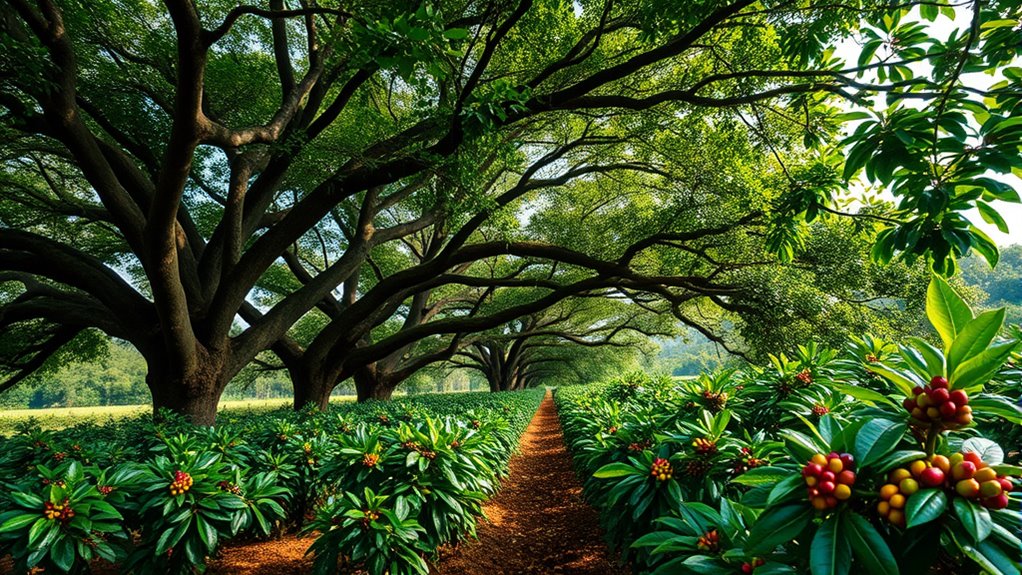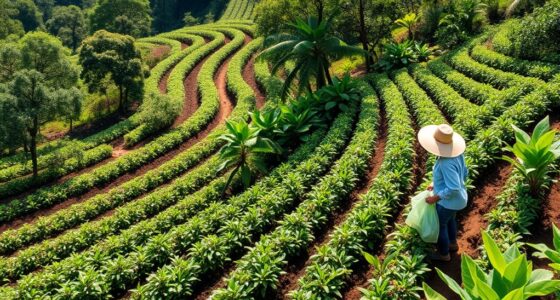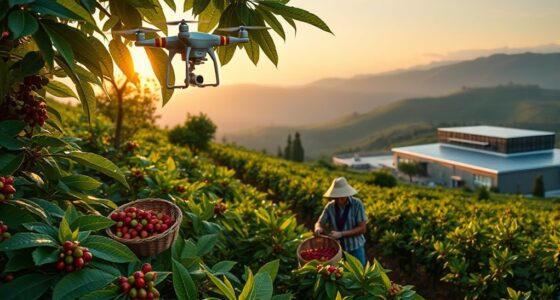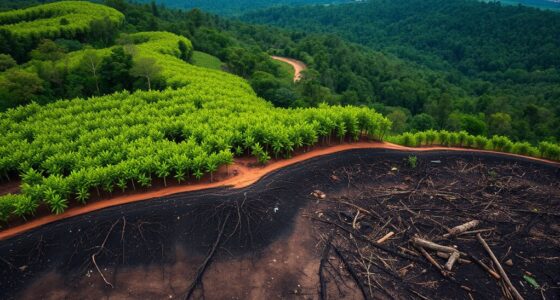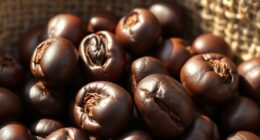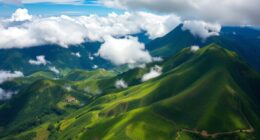Shade-grown coffee matters because it supports biodiversity, providing habitats for birds, insects, and small mammals, which helps maintain healthy ecosystems. It also reduces the need for chemicals, improves soil health, and promotes climate resilience by absorbing carbon. Growing coffee under shade trees mimics natural conditions, creating microclimates that enhance flavor and quality. If you want to discover how shade-grown coffee benefits both the environment and your cup, keep exploring its important role.
Key Takeaways
- Supports biodiversity by providing habitats for birds, insects, and small mammals.
- Enhances soil health and reduces chemical use through natural ecosystem balance.
- Sequesters carbon, helping mitigate climate change impacts on coffee farms.
- Improves coffee flavor and quality by slowing maturation in shaded environments.
- Promotes sustainable farming practices that preserve ecosystems and protect wildlife.

Shade-grown coffee is cultivated under a canopy of trees that mimic natural forests, supporting biodiversity and promoting ecological health. When you choose shade-grown coffee, you’re supporting farming practices that preserve the complex web of life in coffee-growing regions. The shade trees provide an essential habitat for a variety of species, including migratory birds, insects, and small mammals, helping to maintain a balanced ecosystem.
These natural habitats foster biodiversity, which is imperative for resilient farm environments and overall ecological stability. The presence of shade trees influences the health of coffee plants by creating a microclimate that reduces temperature extremes and preserves soil moisture. This environment encourages the growth of healthy coffee plants while also slowing maturation, which improves flavor profile and quality.
Unlike sun-grown coffee, shade-grown varieties require fewer chemical inputs because the shade trees help control pests naturally. This natural pest control minimizes the need for chemical pesticides, making the coffee more sustainable and environmentally friendly. By maintaining forest conditions, shade-grown coffee farms also contribute to carbon sequestration.
The canopy of shade trees absorbs CO2 from the atmosphere, helping to mitigate climate change. This process not only benefits the environment but also supports farmers by enhancing the farm’s overall resilience to climate impacts. Additionally, shade-grown coffee encourages reforestation efforts, restoring degraded lands and reducing deforestation pressures on natural forests.
Choosing shade-grown coffee means supporting agricultural systems that promote ecological health and sustainability. The diverse forest conditions created by shade trees sustain a wide range of species and help preserve important habitats for migratory birds and other wildlife. These birds rely on the canopy for food, shelter, and nesting sites, making shade-grown coffee essential for their survival during migration seasons. Incorporating biodiversity conservation into coffee farming practices ensures the preservation of these vital ecosystems for future generations.
Frequently Asked Questions
Why Is Shade-Grown Coffee Better?
You might wonder why shade-grown coffee is better. It’s because growing coffee under canopy cover helps beans mature more slowly, developing richer flavors and smoother profiles.
The shade reduces caffeine and acidity, creating a gentler taste. Plus, it encourages ecological interactions like pest control and pollination, boosting quality.
What Is One Drawback of Growing Coffee in the Shade?
One drawback of growing coffee in the shade is that it can lead to lower productivity because shade-grown coffee often yields fewer beans per hectare.
You might also face longer harvest cycles since cherries mature more slowly under shaded conditions.
Additionally, dense shade can make machine harvesting difficult, forcing you to rely on labor-intensive hand-picking, which increases your labor costs.
Proper management is essential to balance shade and yield.
Why Is Shade-Grown Coffee Better for Birds?
You might wonder why shade-grown coffee is better for birds. It provides critical habitats with complex canopy layers and diverse flora, offering nesting sites and food sources.
Bird abundance and diversity increase markedly on shaded farms, supporting local ecosystems. These environments also attract insectivorous and frugivorous birds, which help control pests naturally.
Does Starbucks Use Shade-Grown Coffee?
You’re wondering if Starbucks uses shade-grown coffee. Yes, they do, but not exclusively. The company is committed to sourcing ethically and sustainably, including shade-grown options through their C.A.F.E. Practices certification.
While only a portion of their coffee is shade-grown, Starbucks actively promotes these farming methods to support biodiversity, improve coffee quality, and protect the environment. They’re working to increase shade-grown coffee in their supply chain by partnering with organizations like Conservation International.
Conclusion
By choosing shade-grown coffee, you help protect crucial ecosystems and promote sustainable farming practices. Your decision supports biodiversity, conserves water, and reduces chemical use, making a positive impact on the environment. Every cup you enjoy can contribute to healthier forests and better livelihoods for farmers. So, next time you buy coffee, opt for shade-grown options. It’s a simple way to make a meaningful difference for the planet and future generations.
